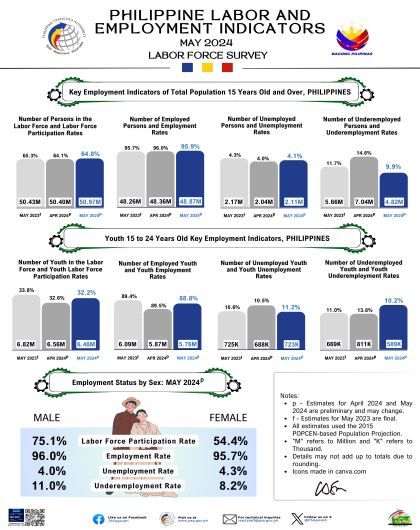| Philippines | April 2010 1/ | April 2009 |
| Population 15 years and over (in '000) | 60,562 | 59,074 |
| Labor Force Participation Rate (%) | 63.6 | 64.0 |
| Employment Rate (%) | 92.0 | 92.5 |
| Unemployment Rate (%) | 8.0 | 7.5 |
| Underemployment Rate (%) | 17.8 | 18.9 |
Notes: 1/ Estimates for April 2010 are preliminary and may change.
2/ Population 15 years and over is from the 2000 Census-based population projections
The number of employed persons in April 2010 was estimated at 35.4 million. This placed the current employment rate at 92.0 percent, which is not significantly different from the estimate reported last year at 92.5 percent. The April 2010 LFS survey also revealed that the size of the labor force was approximately 38.5 million out of the estimated 60.6 million population 15 years old and over. This translates to a labor force participation rate of 63.6 percent.
Across regions, the National Capital Region (NCR) posted the lowest employment rate at 88.2 percent. Zamboanga Peninsula registered the highest employment rate at 96.9 percent.
Of the total 35.4 million employed persons in April 2010, more than one-half (52.0%) worked in the services sector with those employed in wholesale and retail trade, repair of motor vehicles, motorcycles and personal and household goods sub-sector comprising the largest sub-sector (19.4% of the total employed). Workers in the agriculture sector accounted for 32.5 percent of the total employed, with those engaged in the agriculture, hunting and forestry sub-sector making up the largest sub-sector (28.4% of the total employed). Only 15.5 percent of the total employed were in the industry sector, with the manufacturing sub-sector making up the largest percentage (8.6% of the total employed).
Among the various occupation groups, laborers and unskilled workers predominated at 32.2 percent of the total employed persons in April 2010. Farmers, forestry workers and fishermen was the second largest group, accounting for 15.6 percent of the total employed.
Employed persons fall into any of these categories: wage and salary workers, own account workers and unpaid family workers. Wage and salary workers are those who work for private households, private establishments, government or government corporations and those who work with pay in own-family operated farm or business. More than half (54.5%) of the employed persons were wage and salary workers, while more than one-third (33.7%) were own-account workers, and 11.8 percent were unpaid family workers. Among the wage and salary workers, those working for private establishments comprised the largest proportion (40.2% of the total employed). Government workers or those working for government corporations comprised only 8.9 percent of the total employed, while 5.1 percent were workers in private households. Meanwhile, among the own-account workers, the self-employed comprised the majority (30.2% of total employed).
Employed persons are classified as either full-time workers or part-time workers. Full-time workers are those who work for 40 hours or more during the reference week while part-time workers work for less than 40 hours. The number of full-time workers in April 2010 was recorded at 21.7 million while the number of part-time workers was 13.0 million in April this year.
Employed persons who express the desire to have additional hours of work in their present job or to have additional job, or to have a new job with longer working hours are considered underemployed. The number of underemployed persons in April 2010 was estimated at 6.3 million or an underemployment rate of 17.8 percent. More than half of the total underemployed (3.7 million or 58.7%) were reported as visibly underemployed or working less than 40 hours during the reference week. Those working for 40 hours or more accounted for 38.0 percent. Most of the underemployed were working in the agriculture sector (44.9%) and services sector (39.6%). The underemployed in the industry sector accounted for 15.4 percent.
The number of unemployed persons in April 2010 was estimated at 3.1 million compared to last year's estimate of 2.8 million. This placed the current unemployment rate at 8.0 percent which is not significantly different from last year's estimate of 7.5 percent.
More males (62.5% of total unemployed) were unemployed than females (37.5%). By age group, for every 10 unemployed persons, five (51.2%) were in the age group 15 to 24 years while three (29.6%) were in the age group 25 to 34 years. By education, 44.5 percent of the unemployed had reached at most high school level while 41.6 percent had attained college level.
-
Starting in July 2003, the Labor Force Survey (LFS) adopted the 2003 Master Sample Design. Using this master sample design, the number of samples increased from 41,000 for LFS conducted from January 1997 to April 2003 to around 51,000 sample households for July 2003 and subsequent rounds of the LFS.
-
The 1992 four-digit code for Philippine Standard Occupational Classification (PSOC) and 1994 Philippine Standard Industrial Classification (PSIC) were used in classifying the occupation and industry.
-
Starting April 2005, the new unemployment definition was adopted per NSCB Resolution Number 15 dated October 20, 2004. As indicated in the said resolution, the unemployed include all persons who are 15 years and over as of their last birthday and are reported as: (1) without work and currently available for work and seeking work; or (2) without work and currently available for work but not seeking work for the following reasons:
1.) Tired/believed no work available
2.) Awaiting results of previous job application
3.) Temporary illness/disability
4.) Bad weather
5.) Waiting for rehire/job recall -
Starting with the January 2007 LFS round, the population projections based on the 2000 Census of Population was adopted to generate the labor force statistics. This is in compliance with NSCB Resolution No. 1 series of 2005 entitled "Adoption of the Methodology Used in Generating the 2000 Census of Population and Housing-Based National Population Projections"..


